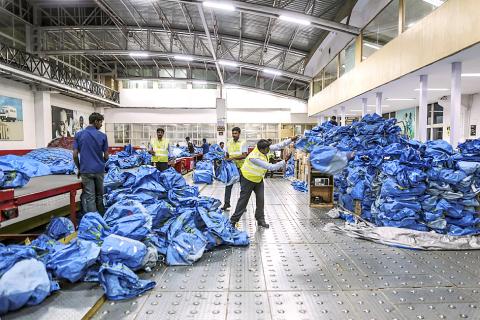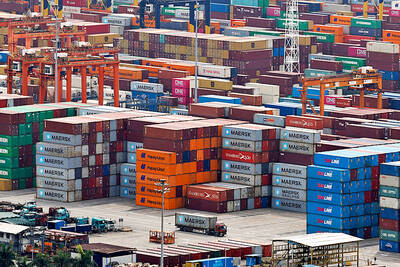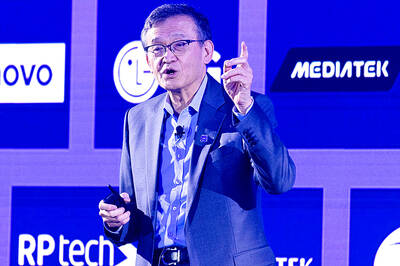About five years ago, e-commerce did not mean much for India’s biggest package shipping company. Now, with a boom in online shopping in the nation of 1.2 billion people, Blue Dart Express Ltd is expanding.
The unit of DHL Express is adding a Boeing Co 757 freighter airplane to its fleet of five in the South Asian country and building warehouses for sellers using portals such as Amazon.com Inc and Flipkart.com, DHL eCommerce chief executive Malcolm Monteiro said in an interview in Mumbai.
“Up to five years ago, you never had e-commerce figuring in Blue Dart’s list of top five verticals,” said Monteiro, who oversees all of Blue Dart’s operations. “Today, it is the largest vertical and demand is far outstripping supply.”

Photo: Bloomberg
India’s online retail market has grown to about US$6 billion in five years, as free delivery and heavy discounting lure millions to buy everything from lingerie to furniture. Yet, e-commerce is just getting started. Online sales are likely to reach 3 percent of the entire Indian retail market by 2020 from less than half a percent now, PriceWaterhouseCoopers LLP said in August last year.
Shares of the nation’s major logistics and delivery companies have surged in the past 12 months, partly due to e-commerce demand.
Blue Dart has more than doubled to 6,816.25 rupees, while Gati Ltd, in which Japan’s Kintetsu World Express Inc has a stake, has more than quadrupled to 245.30 rupees, according to data compiled by Bloomberg.
The demand is also spawning competition as start-ups take on established shippers with cheaper rates. New entrants Delhivery Pvt, Ecom Express Pvt and Gojavas Pvt have received millions of US dollars in funding from venture capital and private equity firms, and are carving out low-cost delivery operations aimed solely at Web retailers.
Meanwhile, Blue Dart is betting customers will pay a premium for its services as its wide network developed over 31 years gives it an edge when flash sales and festival offers cause a surge in orders and expose chinks in its nimbler rivals.
E-commerce sales in India hit an all-time high in October last year, and so did complaints from disgruntled customers on lost, delayed or stolen orders. There just were not enough planes and employees to deliver the packages.
Amazon India and Flipkart did not immediately respond to an e-mailed questionnaire about their experience with delivery companies.
Blue Dart is the only operator of domestic cargo-only jets in India, with five 757 aircraft in its fleet.
“Running an air cargo operation is not something every logistics company can do,” Technopak Advisors Pvt retail associate vice president Pragya Singh said in a telephone interview. “This is a capability they have and are using that to attract customers.”
Rivals that rely on cargo space on commercial carriers are more susceptible to delays at distribution hubs, New Delhi-based Singh said. This bottleneck might get worse during festival seasons, when all seats are occupied, leaving less space for cargo.
Blue Dart’s near monopoly on cargo routes might be luring some commercial airliners as well. Jet Airways India Ltd, India’s second-biggest carrier, plans to enter the air cargo business and might lease three planes from Etihad Airways PJSC, the Business Standard newspaper said on Monday.
Courting e-commerce business would provide huge volumes for Blue Dart, but it could also increase the risk of delays for its core clients — premium business customers who are less forgiving.
The company, 75 percent owned by Deutsche Post AG’s DHL unit, gets its core profit from business-to-business transactions that place a premium on reliability and speed. Packages are often small and most customers’ offices tend to be clustered in key business districts that are easy to access.
E-commerce logistics is all about “thin margins, low price points and scattered delivery all over the country,” said Suvir Sujan, cofounder of Nexus Venture Partners, which was an early investor in Delhivery.
There are more than 100,000 zip codes in India, and logistics providers need to be prepared to deliver apparel or a pair of shoes anywhere.
For its part, Blue Dart keeps some of its business and e-commerce teams separate, so as to serve both sides of its operation, Monteiro said. It also outsources some of the deliveries to keep costs low.
The company is also opening warehouses where sellers on e-commerce portals can store goods. Each time an order comes in, the product is packed and shipped to the consumer, saving time as the couriers do not have to go to the seller’s location to pick up the item. Blue Dart has opened its first such warehouse, known in the industry as a fulfillment center, in Delhi, Monteiro said.
“There’s a huge shortage of fulfillment centers all across” India, Monteiro said.
Blue Dart is preparing to open as many as 15 such warehouses depending on demand.

The Eurovision Song Contest has seen a surge in punter interest at the bookmakers, becoming a major betting event, experts said ahead of last night’s giant glamfest in Basel. “Eurovision has quietly become one of the biggest betting events of the year,” said Tomi Huttunen, senior manager of the Online Computer Finland (OCS) betting and casino platform. Betting sites have long been used to gauge which way voters might be leaning ahead of the world’s biggest televised live music event. However, bookmakers highlight a huge increase in engagement in recent years — and this year in particular. “We’ve already passed 2023’s total activity and

Nvidia Corp CEO Jensen Huang (黃仁勳) today announced that his company has selected "Beitou Shilin" in Taipei for its new Taiwan office, called Nvidia Constellation, putting an end to months of speculation. Industry sources have said that the tech giant has been eyeing the Beitou Shilin Science Park as the site of its new overseas headquarters, and speculated that the new headquarters would be built on two plots of land designated as "T17" and "T18," which span 3.89 hectares in the park. "I think it's time for us to reveal one of the largest products we've ever built," Huang said near the

China yesterday announced anti-dumping duties as high as 74.9 percent on imports of polyoxymethylene (POM) copolymers, a type of engineering plastic, from Taiwan, the US, the EU and Japan. The Chinese Ministry of Commerce’s findings conclude a probe launched in May last year, shortly after the US sharply increased tariffs on Chinese electric vehicles, computer chips and other imports. POM copolymers can partially replace metals such as copper and zinc, and have various applications, including in auto parts, electronics and medical equipment, the Chinese ministry has said. In January, it said initial investigations had determined that dumping was taking place, and implemented preliminary

Intel Corp yesterday reinforced its determination to strengthen its partnerships with Taiwan’s ecosystem partners including original-electronic-manufacturing (OEM) companies such as Hon Hai Precision Industry Co (鴻海精密) and chipmaker United Microelectronics Corp (UMC, 聯電). “Tonight marks a new beginning. We renew our new partnership with Taiwan ecosystem,” Intel new chief executive officer Tan Lip-bu (陳立武) said at a dinner with representatives from the company’s local partners, celebrating the 40th anniversary of the US chip giant’s presence in Taiwan. Tan took the reins at Intel six weeks ago aiming to reform the chipmaker and revive its past glory. This is the first time Tan